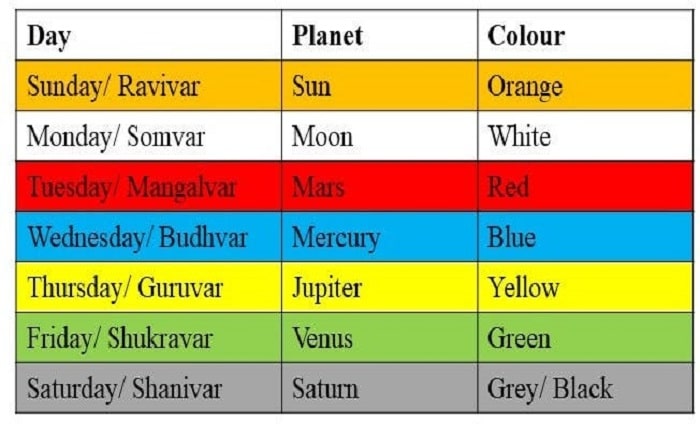Navratri Colours: Significance, Tradition & Daily Dress Code for 9 Days of Celebration

Navratri Colours: An Introduction to Their Cultural Importance
Navratri colours hold immense significance during the nine-day Hindu festival dedicated to Goddess Durga. These Navratri colours symbolize different energies and virtues, with each day of the festival associated with a specific hue. Wearing the respective Navratri colours daily is not just a tradition but a way of aligning with the divine energies invoked during the festival. These Navratri colours also reflect the mood and spirit of each day, influencing celebrations across India.
Navratri Colours: Day 1 – Grey and the Power of New Beginnings
On the first day of Navratri, the chosen Navratri colour is grey, representing the power of transformation and humility. Grey signifies the calm before the storm, as devotees invoke Shailaputri, the first form of Goddess Durga. Wearing this Navratri colour sets the tone for spiritual awakening and new beginnings. Many believe that donning grey on Day 1 helps in removing negativity and embracing self-discipline, making this Navratri colour a powerful start to the festival.
Navratri Colours: Day 2 – Orange and Its Vibrancy of Energy
The Navratri colour for Day 2 is orange, a bright and vibrant shade symbolizing energy, enthusiasm, and happiness. Associated with Brahmacharini, the second form of the goddess, this Navratri colour encourages individuals to maintain balance and commitment. People wear orange outfits on this day to attract positivity and warmth, which are vital during Navratri celebrations. This Navratri colour energizes the environment and lifts everyone’s festive spirit.
Navratri Colours: Day 3 – White and the Essence of Peace
White is the Navratri colour for the third day and stands for purity, peace, and serenity. Devotees worship Chandraghanta, the warrior form of Durga, while embracing the calm energy this Navratri colour brings. Wearing white is believed to invite divine blessings and mental clarity. This Navratri colour allows people to reflect inwardly and maintain peace amidst the fervor of celebrations, making it one of the most sacred Navratri colours.
Navratri Colours: Day 4 – Red and Its Symbolism of Passion
The fourth day of Navratri is marked with the bold Navratri colour red, representing passion, love, and strength. The goddess form worshipped is Kushmanda, and the red Navratri colour resonates with her fiery energy. Red brings confidence and power, motivating devotees to face challenges with courage. Choosing this Navratri colour reflects intense devotion and a readiness to overcome all obstacles in life, keeping the festive mood alive and spirited.
Navratri Colours: Day 5 – Royal Blue and Its Divine Tranquility
Royal Blue is the Navratri colour for Day 5 and signifies divine energy and tranquility. Associated with the goddess Skandamata, this Navratri colour represents depth and wisdom. Wearing royal blue during Navratri brings calmness and spiritual strength, helping devotees stay focused and devoted. This Navratri colour also adds elegance and charm to festive outfits, making it a favorite among fashion-conscious worshippers.
Navratri Colours: Day 6 – Yellow and Its Radiant Optimism
On Day 6, the Navratri colour is yellow, symbolizing cheerfulness, positivity, and enlightenment. The goddess worshipped is Katyayani, and this Navratri colour aligns with her fierce yet radiant nature. Wearing yellow is said to uplift the spirit and bring hope. This bright Navratri colour is often paired with gold accessories, reflecting prosperity and festive joy. Yellow during Navratri creates a vibrant atmosphere that complements the celebrations beautifully.
Navratri Colours: Day 7 – Green and Its Message of Growth
Day 7 celebrates the goddess Kalaratri, and the Navratri colour of the day is green. Green represents nature, fertility, and growth, making it an essential Navratri colour. It embodies balance, harmony, and life’s renewal process. Wearing green during Navratri not only connects you with nature’s energies but also promotes healing and self-improvement. Among all Navratri colours, green brings a refreshing change to the festive wardrobe while reflecting spiritual progress.
Navratri Colours: Day 8 – Peacock Green and the Shade of Elegance
Peacock Green is the Navratri colour for Day 8, representing elegance, uniqueness, and grace. This shade is associated with Mahagauri, the eighth form of Durga known for her beauty and calm nature. Wearing this Navratri colour enhances personal charm and reflects inner purity. Peacock green is a combination of blue and green, both considered auspicious Navratri colours, making it a beautiful choice for devotees seeking peace and sophistication in their celebrations.
Navratri Colours: Day 9 – Purple and the Vibe of Power and Ambition
The final Navratri colour, purple, is dedicated to the goddess Siddhidatri and symbolizes ambition, dignity, and power. Purple stands out among Navratri colours as it reflects royalty and wisdom. Devotees wear this vibrant colour to end the festival with grandeur and spiritual fulfillment. Purple, being a rare and strong Navratri colour, reminds us to connect with the divine power within ourselves and celebrate Navratri’s culmination with intensity and reverence.
Conclusion
In conclusion, Navratri colours are more than just fashion statements—they are powerful symbols of divine energy, emotions, and intentions. Each Navratri colour brings a unique vibration that connects devotees to different forms of Goddess Durga. Following the daily Navratri colours not only enhances the festive spirit but also brings discipline and mindfulness into one’s life. Whether you’re participating in Garba nights, temple rituals, or home pujas, embracing Navratri colours daily helps you align with the spiritual rhythm of the festival.
FAQs
1. What are the 9 Navratri colours for 2025?
The 9 Navratri colours for 2025 will follow the traditional pattern: grey, orange, white, red, royal blue, yellow, green, peacock green, and purple, with each colour symbolizing a unique form of energy and devotion.
2. Why do we wear specific Navratri colours each day?
Navratri colours are worn to honor the goddess of the day. Each Navratri colour represents a specific quality or energy that resonates with that form of Durga, enhancing spiritual connection and positivity.
3. Can men also follow the Navratri colours tradition?
Yes, men can absolutely follow the Navratri colours tradition. They can wear shirts, kurtas, or accessories in the respective Navratri colours to participate in the festive spirit.
4. Is there a fixed sequence for Navratri colours every year?
The Navratri colours follow a fixed sequence based on the weekday Navratri starts. However, the actual colours may shift based on the first day’s alignment, but the 9 Navratri colours remain constant.
5. How can I plan my wardrobe around Navratri colours?
You can plan your wardrobe by preparing 9 outfits in the Navratri colours. Mix traditional and modern styles, coordinate accessories, and ensure each day’s colour reflects the spiritual theme of that day.





